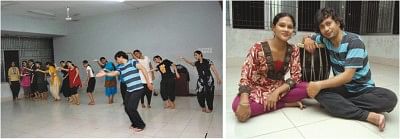Generating interest in ‘Chhau’ dance

Swapan Majumder (centre) with students at the workshop (left). Sucheta and Swapan(right).
Swapan Majumder is an Indian exponent of Chhau dance and his wife Sucheta, a Bangladeshi, is a Kathak artiste. The dancer duo is now in Dhaka to conduct a workshop on dance. Noted Bangladeshi dancers Shamim Ara Nipa and Shibli Mohammad of Nrityanchal are organising the workshop. Starting from June 6, the workshop is on at Bangladesh Shilpakala Academy and will continue till June 21.
It is difficult to determine the exact origins of Chhau. The three forms of Chhau are named after the regions where they were practiced -- Purulia Chhau of West Bengal, Seraikela Chhau of Bihar and Mayurbhanj Chhau of Orissa. Ancient scriptures refer to the dance form's martial origins, suggesting that the term “Chhau” was derived from the local dialect meaning an army camp. Apparently warriors, in their leisure, developed this dance form as an expression of celebration. Often dealing with gods, goddesses and other mythic characters, Chhau dance features steps called Chali and Dharan (Mayurbhanj style) and is accompanied with musical instruments like shanai, dhol and dhamsha. While, the Seraikela and Purulia sub-genres of Chhau use masks, the Mayurbhanj style uses none.
In between training young dancers, Swapan and Sucheta talked to The Daily Star (TDS).
TDS: What's your impression of Bangladeshi dance?
Swapan: Before coming here, I presumed that perhaps, Bangladeshi dancers predominantly work with folk dance as most of the Bangladeshi students studying in Delhi have a great penchant for the genre. But now I've realised that students are equally eager to learn different forms of classical dance. They proceed with utmost sincerity. This is truly inspiring!
TDS: How do you evaluate the participants attending your workshop?
Swapan: To be very frank, they try their best but at times find it difficult to grasp all the elements, as physical expressions are quite frequent in this form of dance. The students might find the lessons challenging but they are really enthusiastic and try to grasp things quick. I've also allocated an extra hour for them in this regard.
TDS: Why did you choose Chhau as your dance style?
Swapan: I used to be a student of Kathak. After training in Kathak for six years I realised that the style might not be suitable for my physique and I started taking interest in Chhau. Gradually, the dance form appealed more to me. I've performed Chhau in many countries including a major show in Edinburgh, UK.
TDS: Your wife is also a dancer. Does it create issues in your conjugal life?
Swapan: Not at all! Rather we can work together and encourage each other.
TDS: Tell us about your background in dance…
Sucheta: Kathak is my passion. My Kathak lessons started under Shibli Mohammad. Later, with a scholarship, I went to India and completed a diploma on Kathak. I also learnt Chhau at Bharatiya Kala Kendra. I also attended Ballet classes there. Currently I teach at Indian schools.
TDS: Unfulfilled ambition?
Sucheta: I'm in search of a guru. Though I have trained in Kathak for five years, I feel like I still know nothing about it. I would like to take Kathak lessons till the end and I want to do something remarkable in this field.
Swapan: All my aspirations involve dance.
Swapan Majumder and Sucheta, accompanied by dancers of Nrityan-chal, will perform at Bangladesh Shishu Academy auditorium on June 21 at 7 pm.

 For all latest news, follow The Daily Star's Google News channel.
For all latest news, follow The Daily Star's Google News channel. 



Comments